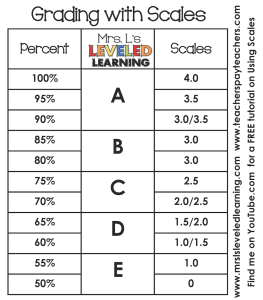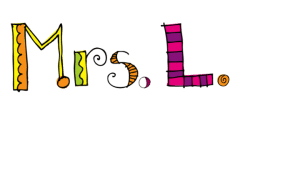
The following excerpts are from a parent letter I developed to explain these differences to parents. This letter is available for free in an editable two-page MS Word document format so you can adjust it to your own classroom grading routines. Just follow the link and download.
Dear Families,
This year I will be evaluating student performance in a way that may seem very different than traditional grading methods. In my classroom I have created some learning goals and performance scales for several different subjects. Learning Goals are posted statements that help students focus on exactly what they are supposed to learn and master from instruction. Performance Scales express a gradient of mastery towards the learning goal, just as an ‘A’, ‘B’, or ‘C’ represents different levels of mastery in a traditional grading system. The specific structure of the 4.0 scale is explained below in more detail.
4.0 means, “I know this skill/concept so well I could explain it to others, or extend it to new situations.”
* 3.0 means, “I know this skill/concept well enough to have mastered the grade-level expectation.”
2.0 means, “I am still working towards the grade-level expectation, and getting closer.”
1.0 means, “ I need extra support to perform in this area.”
0.0 means, “ Even with help, I do not understand this skill/concept.”
Scales can be used informally (i.e. the teacher says to the class, “Show me on your fingers where you think you are now.”) or formally (i.e. the teacher assigns specific tasks to each level). The 3.0 scale is the standard for a child to master grade level skills. However, a student who ‘passes’ a skill with a 3.0, will be asked to keep working toward a 4.0 if time and opportunity allow. For grading purposes, the scales have had percentages assigned to them based on their meaning.
Traditional letter grading is typically based on points and percentages (i.e. 20/25 points = 80% B-.) Your child may receive grades based on both forms of assessment, depending on the assignment. See examples of the grading methods used for different assignments below.
Show them a scale! Your administrators may have instructed you to use something similar. Follow my Resources tab above and then choose Grading with Scales for more explanation of the 4-point scale that aligns to the traditional grading system based on 100%.
Many of my materials are free, and I offer a few sample pages of the grade level Math Assessments, Posters, and free Student Portfolio pages for tracking their progress quickly and simply. I hope you find this guide to be a useful time-saver!



Is this parent letter document still available? The link won’t work.
Thanks!